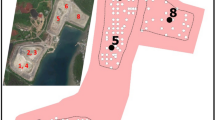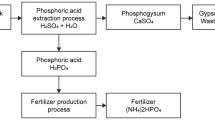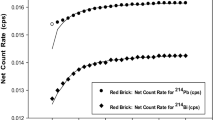Abstract
Phosphogypsum (PG) was treated to reduce activity concentrations of 226Ra, which was found to exceed that permitted by international regulations. Treatment methods using hybrid water treatment, sulphuric acid treatment, mixed acid (H2SO4 and HNO3) treatment, household water treatment and calcium carbonate powder treatment were applied. Reduction of 226Ra content in phosphogypsum by 80–85 % can be achieved using these treatment processes. The radium equivalent activity (Raeq), gamma index (I γ ), alpha index (I α ), absorbed gamma dose rate (D in), and corresponding annual effective dose (E in) were evaluated for public exposure due to the use of treated phosphogypsum in building materials and for other purposes. The calculated values of the (Raeq), (I γ ), and (I α ) for all the treated phosphogypsum samples are significantly below the recommended upper level of unity used as an index of radiological hazard. The measured mean value of the (D in) is about 20 % lower than the population-weighted average value of 84 nGy h−1 for the indoor absorbed dose rate. The estimated values of the indoor annual effective dose for all the treated phosphogypsum samples are significantly below the recommended upper level of 1 mSv. The mean value of the (E in) is about 70 % lower than upper level of 1 mSv. In the overall assessment, it can be concluded that using treated PG in proportions up to 100 % of building materials and other applications will be safe from the radiation protection perspective.


Similar content being viewed by others
References
Agbalagba EO, Avwiri GO, Ononugbo CP (2013) Evaluation of naturally occurring radioactivity materials (NORM) of soil and sediments in oil and gas wells in western Niger Delta Region of Nigeria. Environ Earth Sci. doi:10.1007/s12665-013-2312-4
Al-Hwaiti M, Zielinskia R, Budahn J, Ranville J, Ross P (2010) Distribution and mode of occurrences of radionuclides in phosphogypsum from the Aqaba and Eshidiya fertilizer plants, Jordan. Chinese J Geochem 29:261–269
Al-Hwaiti M, Al-Khashman O, Al-Khateeb L, Freig F (2014) Radiological hazard assessment for building materials incorporating phosphogypsum made using Eshidiya mine rock in Jordan. Environ Earth Sci 71(5):2257–2266
Al-Jabbari S, Faisal F, Ali S, Nasir S (1988) The physical methods for purification of the phosphogypsum for using it as building material. J Build Res Sci Res Council Baghdad 7:49–69
Al-Karouf SJ, Al-Hamarneh IF, Dababneh M (2008) Natural radioactivity, dose assessment and uranium uptake by agricultural crops at Khan Al-Zabeeb, Jordan. J Environ Radioact 99:1192–1199
Al-Masri MS, Al-Bich F (2001) Polonum-210 distribution in Syria phosphogypsum. J Radioanal Nucl Chem 251(2002):431–435
Al-Sulaiti H, Alkhomashi N, Al-Dahan N, Al-Dosari M, Bradley DA, Bukhari S, Matthews M, Regan PH, Santawamaitre T (2011) Determination of the natural radioactivity in Qatarian building materials using high-resolution gamma-ray spectrometry. J Nucl Instr Methods Phys Res 652:915–919
Azouazi M, Ouahidi Y, Fakhi S, Andres Y, Abbe J, Benmansor M (2001) Natural radioactivity in phosphates, phosphogypsum and natural waters in Morocco. J Environ Radioact 54:231–242
Berekta J, Mathew PJ (1985) Natural radioactivity of Australian building materials waste and by-products. J Health Phys 48:87
Burnett WC, Cowart JB, LaRock P, Hull CD (1995) Microbiology and radiochemistry of phosphogypsum. Florida Institute of Phosphate Research (FIPR) publication, 05-035-115
Cañete SJ, Palad LJ, Enriquez EB, Garcia TY, Yulo-Nazarea T (2008) Leachable 226Ra in Philippine phosphogypsum and its implication in groundwater contamination in Isabel, Leyte, Philippines. Environ Monitor Assess 142(1–3):337–344
Carmichael JB (1988) Worldwide production and utilization of phosphogypsum. In: Proceedings of the second international symposium on phosphogypsum. Miami, Florida, USA Florida Institute of Phosphate Research (FIPR) publication 01-060-083
Currie LA (1968) Limits for qualitative detection and quantitative determination. Anal Chem 40:586–593
Dragović S, Mandić LJ, Momčilović M, Onjia A (2006) Assessment of gamma dose rate from terrestrial exposure in Serbia and Montenegro. J Radiat Protect Dosimetry 121:297–302
El Afifi EM, Hilal MA, Attallah MF, El-Reefy SA (2009) Characterization of phosphogypsum wastes associated with phosphoric acid and fertilizers production. J Environ Radioact 100:407–412
El-Afifi EM, Attallah M, Hilal M, El-Reefy S (2010) Treatment of TENORM waste: phosphogypsum produced in fertilizer industry. J Radiochem 52(41):441–445
El-Didamony H, Ali NS, Awwad M, Fawzy M, Attallah MF (2011) Treatment of phosphogypsum waste using suitable organic extractants. J Radioanal Nucl Chem. doi:10.1007/s10967-011-1547-3
El-Didamony H, Gado HS, Awwad NS, Fawzy MM, Attallah MF (2013) Treatment of Phosphogypsum waste produced from phosphate ore processing. J Hazard Mater 244–245:596–602
European Commission EC (1999) Radiological protection principles concerning the natural radioactivity of building materials. General Environment, Nuclear Safety and Civil Protection. Radiation protection 112, p 16
Florida Institute of Phosphate Research (1998) How Does Phosphogypsum Storage Affect Ground Waters. Florida Institute of Phosphate Research (FIPR); Publication No. 94-05-042, p 110
Haridasan P, Maniyan C, Pillai P, Khan A (2002) Dissolution characteristics of Ra from phosphogypsum. J Environ Radioact 62:287–294
Ibrahim NM (1999) Natural activities of U, Th and K building materials. J Environ Radioact 43:255–258
Kelly AR, Tingzong G, Roger KS (2002) Stabilization of phosphogypsum using class C fly ash and lime: assessment of the potential for marine applications. J Hazard Mater 93(2):167–186
Kovler K (2009) Radiological constraints of using building materials and industrial by-products. Constr Build Mater 23:246–253
Kovler K, Somin M (2004) Producing environment-conscious building materials from contaminated phosphogypsum. Technion, Haifa
Luther SM, Dudas MJ, Rutherford PM (1993) Radioactivity and chemical characteristics of Alberta phosphogypsum. J Water Air Soil Pollut 69:277–290
Lysandrou M, Pashalidis I (2008) Uranium chemistry in stack solutions and leachates phosphogypsum disposed at a coastal area in Cyprus. J Environ Radioact 99:359–366
Malain D, Regan PH, Bradley DA, Matthews M, Santawamaitre T, Al-Sulaiti H (2010) Measurements of NORM in beach sand samples along the Andaman coast of Thailand after the 2004 tsunami. Nucl Instr Methods Phys Res A 619:41–445
Manjit S, Garg M, Rehsi SS (1993) Purifying phosphogypsum for cement manufacture. Constr Build Mater 7(1):3–7
Manjit S, Mridul G, Verma CL, Handa SK, Rakesh K (1996) An improved process for the purification of phosphogypsum. Constr Build Mater 10(8):597–600
Mas JL, San Miguel EG, Bolivar JP, Vaca F, Pérez-Moreno JP (2006) An assay on the effect of preliminary restoration tasks applied to a large TENORM wastes disposal in the south-west of Spain. J Sci Total Environ 364:55–66
May A, Sweeney JW (1984) Evaluation of radium and toxic element leaching characteristics of Florida phosphogypsum stockpiles. In: Kuntze RA (ed). The Chemistry and Technology of Gypsum. Spec. TECH. Publ. 861. Tuscaloosa (AL): ASTM, pp 140–159
Mazzilli B, Saueia C (1999) Radiological implications of using phosphogypsum as a building material in Brazil. J Radiat Protect Dosimetry 86:63–67
Mazzilli B, Palmiro V, Saueia C, Nisti MB (2000) Radiochemical characterization of Brazilian phosphogypsum. J Environ Radioact 49:113–122
Miller RL, Sutcliffe H (1984) Effects of three phosphate industrial sites on ground-water quality in Central Florida, 1979–1980. US Geological Survey Water Resources Investigations Report 83-4256, p 184
NEA-OECD (1979) Exposure to radiation from natural radioactivity in building materials. Report by Group of Experts of the OECD Nuclear Energy Agency (NEA)
Olmez H, Erdem E (1989) The effect of phosphogypsum on the setting and mechanical properties of Portland cement and trass cement. Cem Concr Res 19:337–384
Olmez H, Yilmaz VT (1988) Infrared study on the refinement of phosphogypsum for cements. Cem Concr Res 18:449–454
Papachristodoulou CA, Assimakopoulos PA, Patronis NE, Ioannides KG (2003) Use of HPGe g-ray spectrometry to assess the isotopic composition of uranium in soils. J Environ Radioact 64:95–203
Potgieter JH, Potgieter SS, McCrindle RI, Strydom CA (2003) An investigation into the effect of various chemical and physical treatments of a South African phosphogypsum to render it suitable as a set retarder for cement. Cem Concr Res 33(8):1223–1227
Pulhani V, Dafauti S, Hegde A (2007) Leaching of uranium, radium and thorium from vertisol soil by ground water. J Radioanal Nucl Chem 274:341
Righi S, Bruzzi L (2006) Natural radioactivity and radon exhalation in building materials used in Italian dwellings. J Environ Radioact 88:58–170
RILEM (2004) International Symposium on Environment-Conscious Material and System for Sustainable Development. Sept 6–7, Koriame, Japan
Roessler CE, Smith ZA, Bolch WE, Prince RJ (1979) Uranium and radium-226 in Florida phosphate materials. Health Phys 37:269–277
Rutherford PM, Dudas MJ, Samek RA (1994) Environmental impacts of phosphogypsum. Sci Total Environ 149(1–2):1–38
Rutherford PM, Dudas MJ, Arocena JM (1995) Radium in phosphogypsum leachates. J Environ Qual 24:307–314
Rutherford PM, Dudas MJ, Arocena JM (1996) Heterogeneous distribution of radionuclides, barium and strontium in phosphogypsum by-product. Sci Total Environ 180:201–209
San Miguel EG, Bolívar JP, García-Tenorio R, Martín JE (2001) 230Th/232Th activity ratios as a chronological marker complementing 210Pb dating in an estuarine system affected by industrial releases. J Environ Pollut 112:361–368
Santos AJG, Mazzilli BP, Fa´varo DIT, Silva PSC (2006) Partitioning of radionuclides and trace elements in phosphogypsum and its source materials based on sequential extraction methods. J Environ Radioact 87:52–61
Szlauer B, Szwanenfeld M, Jakubiec HW, Kolasa K (1990) Hydrobiological characteristics of ponds collecting effluents from a phosphogypsum tip of the Police Chemical Works near Szczecin. Acta Hydrobiologica 32:27–34
Tayibi H, Choura M, Lopez FA, Alguacil JA, Lopez-Delgado A (2009) Environmental impact and management of phosphogypsum (review). J Environ Manag 90:2377–2386
Turhan S, Aykamıs AS, Kılıc AM (2009) Natural radionuclides content and radiological hazed associated with usage of quartz sand samples from Ovacik-Silifke-Mersin open pit as building material in Turkey. Radiat Prot Dosimetry 136:101–107
UNSCEAR (2000) Sources and effects of ionizing radiation. Report to General Assembly, with Scientific Annexes
USEPA (1992) Potential Uses of Phosphogypsum and Associated Risks: Background Information Document. EPA 402-r92-002. USEPA, Washington, DC
Van Der Merwe EM, Strydom CA (2004) Purification of South African phosphogypsum for use as Portland cement retarder by a combined thermal and sulphuric acid treatment method. South Afr J Sci 100:411–414
Yang J, Liu W, Zhang L, Xiao B (2009) Preparation of load-bearing building materials from autoclaved phosphogypsum. J Constr Build Mater 23:687–693
Zielinski R, Al-Hwaiti M, Budahn J, Ranville J, Ross P (2011) Radionuclides, trace elements, and radium residence in phosphogypsum of Jordan. J Environ Geochem Health 33:149–165
Acknowledgments
This research was supported by the Al-Hussein Bin Talal University, the Academic Research Deanship (151/2008) dated June 2, 2008. The author is thankful to Dr. Brian K. Birky, Executive Director of the Florida Industrial and Phosphate Research Institute for review and improvement of the English grammar and composition of this manuscript. The authors would like to thank Mr. Samer Al-Karouf, The Higher Council for Science and Technology (HSCT), for analysis of radionuclides, technical support, and valuable comments. Thanks also go to the anonymous journal reviewers.
Author information
Authors and Affiliations
Corresponding author
Rights and permissions
About this article
Cite this article
Al-Hwaiti, M.S. Assessment of the radiological impacts of treated phosphogypsum used as the main constituent of building materials in Jordan. Environ Earth Sci 74, 3159–3169 (2015). https://doi.org/10.1007/s12665-015-4354-2
Received:
Accepted:
Published:
Issue Date:
DOI: https://doi.org/10.1007/s12665-015-4354-2




